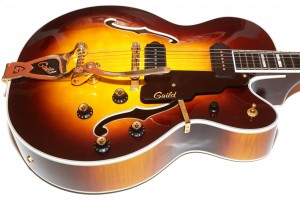
Is this guitar everything I’ve ever wanted in a full-sized Rockabilly Jazz box? Let’s find out.
Introduction
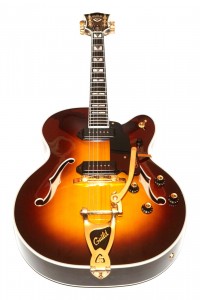
First, the obvious. It has a Guildsby on it! For those not aware, Guildsby is the affectionate nickname given to Bigsby tailpieces that say Guild on them. A Guild with a regular Bigsby just isn’t right to many of the Guild cognoscenti, a group in which I like to pretend to be in good standing by buying all of these guitars and writing all of these articles. The Guildsby makes the guitar an all around different beast than the regular X500s because the Guildsby begs to be manhandled. In addition to the Guildsby, and no doubt also because of it, the bridge is metal instead of ebony.
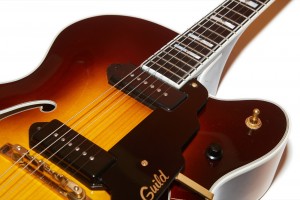
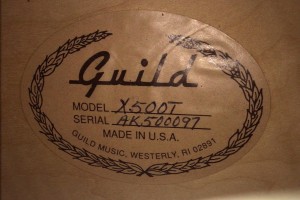
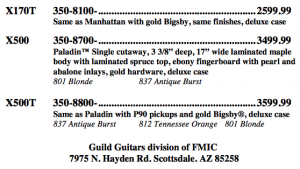
Finish
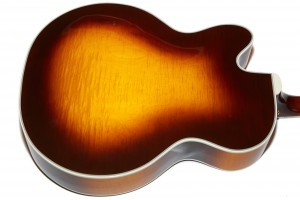
I have no idea of the finish is Lacquer or Poly and, frankly, I just don’t care anymore. I have some guitars where the poly finish is really obvious, and some guitars where I just can’t tell. I can’t tell on this guitar and I’m over caring what finish is on there. Sure, Lacquer ages better, but at this point I’m caring more about how the guitar plays, looks, and feels now and not how it will play, look, and feel in 30 years. That’s for my kids to deal with.
So far as I can discern, this guitar came in this sunburst, blonde, and Tennessee Orange, all of which can be seen though judicious use of Google image search.
Fretboard and Neck
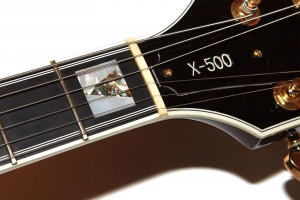
Somehow I had convinced myself that all modern Guilds had 1 11/16″ necks, but much to my continued chagrin, I was clearly mistaken. The neck on this guitar is comfortable enough, but I really wish it was just that little bit wider.
The fretboard is luxurious ebony and the fret marker inlays are abalone and mother of pearl in the high-end V-shaped Guild inlay pattern. The inlays are each perfectly installed and give the guitar a very high-end look from up close or even at stage distance.
The fretboard radius measures at 14″, though all the specs I’ve seen seem to indicate that it should be 16″. I doubt even the most seasoned pro could reliably discern between a 14″ and a 16″ radiused fretboard, so I’m not sure it matters. Hell, maybe I measured wrong; using fretboard gauges is not the most exacting of sciences.
Fret size appears to be size 6230 which is typical for Guild electric frets. In other words, they’re small in an almost fretless wonder sort of way. Guild fans are very accustomed to these frets, but if you’re after super-jumbo frets you’ll need to look elsewhere.
Build Quality
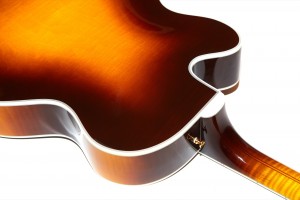
This guitar weighs 8 lbs 7 oz which is a nice weight that seems light after playing my 1986 X500. The weight difference is likely due to the fact that the 1986 X-500 has a large sound-block under the bridge while this 2001 X-500T does not.
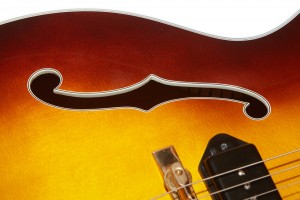
While the visible features are great, many people dislike gold hardware because it fades so easily. One of the benefits of using P90 pickups is that the covers are plastic so there is no gold to wear off, and since the gold-plated pickups are the most obvious wear points on a guitar, the lack of metal covers should allow this guitar to look great for a long time.
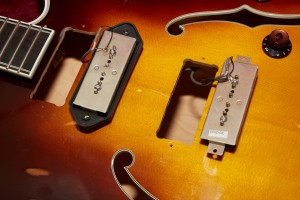
Hans Moust, author of the Guild Guitar Book (which you should absolutely buy if you have even a passing interest in Guild guitars) told me what’s going on in this post on the Let’s Talk Guild forum:
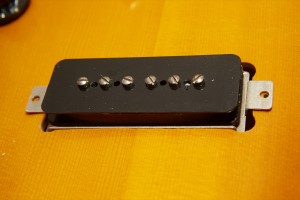
Though this surprised me at first, it only really caught my eye with the pickup covers removed and lets be honest; no one keeps them off since they’re plastic and have no effect on tone. While the metal covers on many humbuckers can cause issues, especially in non-wax-potted models, there are no such issues with these covers, and the only thing I’ve ever removed them for was to either add a spacer to raise them up or to change the covers from black to white or vice-versa.
Pickups
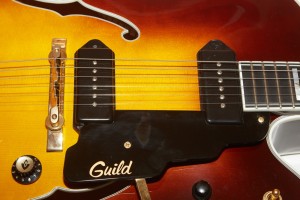
The only thing I can add to that description is that it’s all true and they sound great. I also don’t think Guild used the aged covers referenced in that quote. While Fender made some unwelcome changes to the HB1 pickup while it owned Guild, they did the right thing by using these Seymour Duncan P90s.
Since these are single coils they do not benefit from the humbucker’s design goal of bucking hum, which is to say that they encourage it. If you’ve got ground faults in your electrical wiring or your environment is awash in good old fashioned RF interference, single coil pickups of any kind might annoy you. For lovers of the sound, though, it’s worth the risk.
Electronics
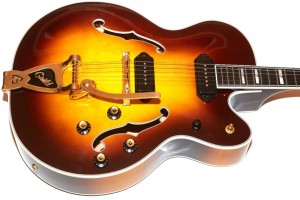
Guild has always liked to make the master volume a smaller knob on the treble side of the guitar and in the case of these big hollow-bodies, they liked to put them next to the pickup selector switch on the bottom bout.
My personal preference is for the pickup selector switch to be on the top bout with the master volume on the lower bout in the way that a Gretsch 6120 is laid out, but that’s a bit nit-picky. I think it’s easier to grab a larger knob that’s not near anything else than it is to do swells on these small knobs which are kind of hiding behind the pick guard on these big jazz boxes.
I also discovered that for my tastes, the pickup selector being on the bottom bout for such a large guitar became problematic while playing in a sitting position because I felt like it it was a big reach to change the pickups where it would have been much easier if the selector switch was on the top bout. It’s not a deal-breaker by any stretch, but I noticed it.
Hardware
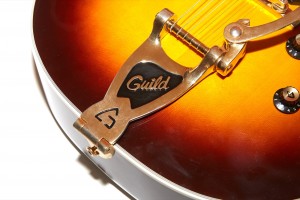
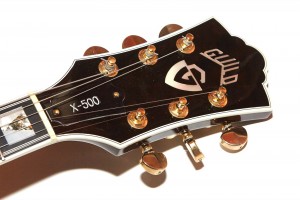
The bridge on this guitar is all-metal which is a contrast to the other X-500s I’ve owned, likely due to the Rockabilly roots of a guitar like this combined with the increased stress induced by the Guildsby.
Sound
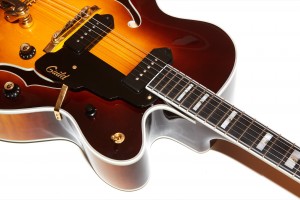
What made the Setzer SSLVO sing, though, was not only the construction of the guitar but those TV Jones Classic pickups which are copies of the original ’59 Filter’Trons. I ended up selling the SSLVO because I felt like I could own two nice Guilds for the $2000 I spent on in, though that math only works when I consider guitars like the Starfire III-90. The X-500 is more inline with the SSLVO’s pricing on the used market.
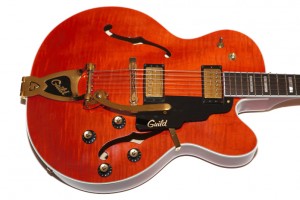
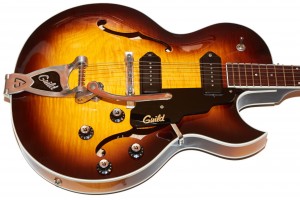
I expected the X500-T to be everything the SF-III-90 was but more-so since it was from the same era (early 2000s), made in the same factory, and had the same pickups. I figured since the X500 was really an upscale deep-body version of the SFIII that the neck would also be 1 11/16″! Sadly, I was wrong about the neck but I was right on every other front.
P90s are single-coil pickups so they retain the chime and high-end sparkle that’s a part of the magic of single coil pickups. Being larger than the single-coils in a Strat or Tele, they also produce more oomph and have a nice midrange punch that you don’t get from those guitars.
Sound Samples
7th Chords
A Barre Chords
Open Chords
Finger Pick
Open Chords 2
Open E
Open E-A-D
Riff
Sleepwalk Intro
The neck pickup produces a delicious jazzy tone with all the woody overtones I’d expect from a jazz box-type guitar such as this. The clarity of the Seymour Duncan Antiquity P90s really pays off here as the tone of the guitar really shines through.
The middle position, with both pickups selected, offers a wonderfully balanced sound where, again, the characteristics of the guitar shine through. The tones in this position are reminiscent of any single coil guitar in the middle position in that the deep bass from the neck pickup is not overpowering while the sharp bite from the bridge pickup is also not present. This is a wonderful position to play in on all of the P90-equipped Guilds I’ve owned and this X500-T is no exception.
The bridge pickup has all the girth and snarl of an angry Les Paul Jr. or SG while also offering some of that wonderful woody tone of the big maple guitar. It’s almost shocking, after playing the jazzy tones of the neck pickup, how aggressive and down right nasty this guitar can get with the bridge pickup.
Playability
This guitar is an absolute joy to play, certainly in part because of it’s high quality and attention to detail, but definitely because of the amazing tones produced by the guitar.
As delightful as this guitar is to play, it is my fervent wish that it had an 1 11/16″ neck, but to be honest that only bothers me when I’m playing complicated jazz chords that are not in my normal wheelhouse. Still, I notice the difference when I pick up my 2002 Starfire III-90 and as a result I like playing that one more.
As stated earlier, I don’t really like the position of the pickup selector switch which kind of surprised me since my Starfire 4 has it in the same position. I think the big difference is that this guitar is twice as thick as the Starfire and thus it’s just that much of a difference when reaching for the switch that I seem to need to move my entire arm, especially while sitting.
Conclusion
This is an amazing guitar that is almost everything I’ve ever wanted in a bigsby-equipped jazz box. My one and only gripe is the 1 5/8″ neck and even that only bugs me when I think about it. If it was 1 11/16″ or even 1 3/4″ it would be utter perfection for me.
Yes, the selector switch is a minor niggle for me, but not one that would prevent me from buying one of these beautiful and elegant guitars. If, on the other hand, Guild were to build a US-made version of this guitar with a 1 11/16″ neck, the pickup selector on the top bout and a larger master volume on the bottom bout where the current switch is, I would sell this one to fund that purchase. You know, if it had P90s and Guild suddenly started producing X500Ts in the US again.
In the end I cannot help but to compare this guitar with my 2002 Guild Starfire III-90, and as much as I love the look, tone, bling and everything else about this X500-T, I have to admit that I prefer the Starfire III-90, and that’s mostly due to the neck which is not only wide, but a bit chunky as well.
This guitar was not cheap. Should you lay out the cash for one? I’d say yes with the caveats listed above, the most important in my mind being the 1 5/8″ neck.
Happy playing!
Donate: PayPal Crypto:
ETH: 0x0AC57f8e0A49dc06Ed4f7926d169342ec4FCd461
Doge: DFWpLqMr6QF67t4wRzvTtNd8UDwjGTQBGs

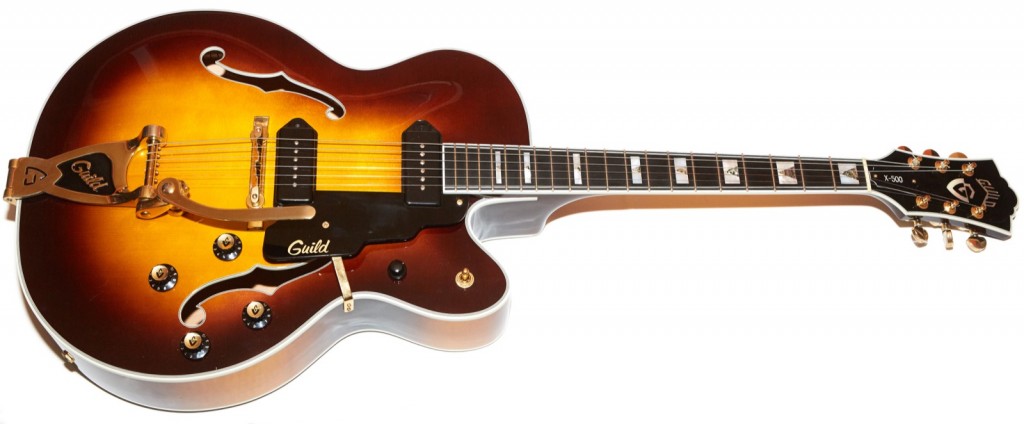
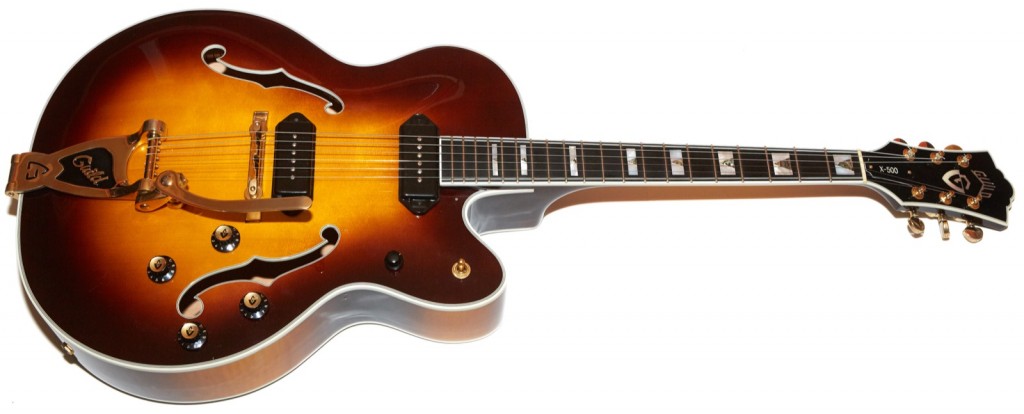
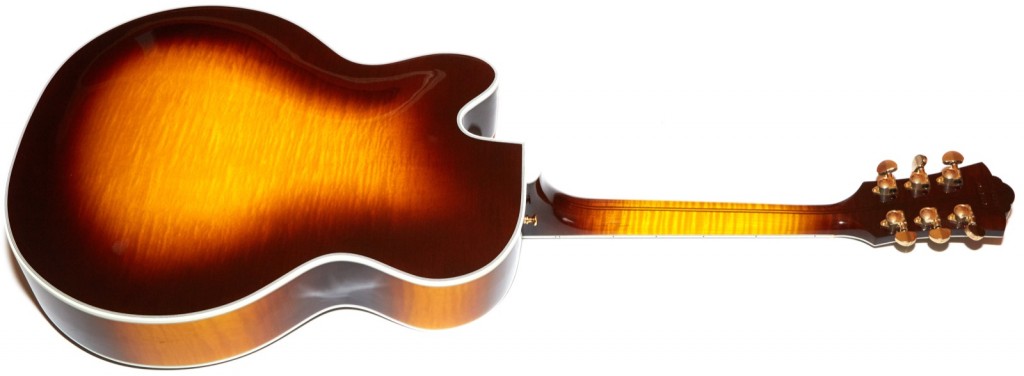
I own an Orange Paladin, Antiquity P90 equipped…. Awesome Guitar on Tube (various) and Solid state (Polytone – JC 120) amps. No One can discuss about guitars without knowing the Guild’s particular feel/workmanship and sound!
I own a Blonde one with P90s and its off the chain ! Amazing guitar!
bought it brand new